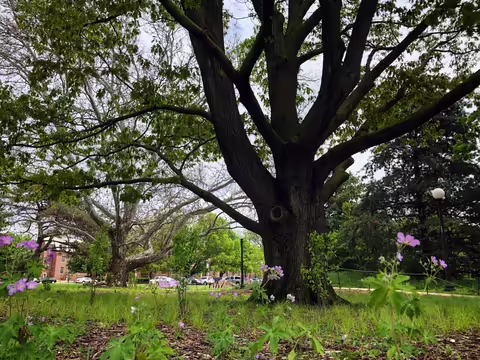URBANA, Ill. – Changing weather patterns in Illinois are leading to increased precipitation which means more flooded streets, water in basements, and headaches for cities. But one increasingly popular solution to this nuisance, green infrastructure, can also address other important societal challenges according to a report from University of Illinois Extension.
“We are getting more rain in Illinois, which means communities are facing increasing stormwater management challenges,” says Lisa Merrifield, University of Illinois Extension Community and Economic Development specialist and lead author on a white paper published by the North Central Regional Water Network. “Many communities are turning to green infrastructure as part of their solution, which when done right can not only serve to stop local flooding, but it can also provide green space and jobs for marginalized communities.”
But are communities making those connections? The network’s green infrastructure team conducted a yearlong study to see if and how green infrastructure and social justice programs were being connected in midwestern communities.
Green infrastructure practices use plants, permeable surfaces and landscaping to store, filter, and reduce stormwater flow to sewer systems or to surface waters.
“We found that some communities are coupling the two, but most are only thinking of green infrastructure as a stormwater management tool,” Merrifield says. “Communities are interested, but need help figuring out how. Illinois Extension staff can serve as a trusted source for information on using green infrastructure to promote environmental and social justice.”
The paper can provide community development professionals, Extension and Sea Grant educators, and water professionals recommendations for integrating green infrastructure projects into communities and address broader societal burdens including pollution and lack of access to green space.
Five key recommendations for implementing green infrastructure programs include:
- Keep it simple. Keep a project simple to lower the cost of installation and maintenance.
- Emphasize co-benefits. Emphasize other societal benefits in addition to stormwater management to earn funding and support.
- Design careers, not jobs. In a growing field such as green infrastructure, creating careers rather than entry-level jobs can increase success.
- Provide education at every level. Providing education sets communities up for long-term success.
- Build relationships and establish partnerships. Like many interdisciplinary projects, collaborating with partners is crucial to successful project implementation.
The team’s recommendations are based on the findings from 18 listening sessions in communities to identify and prioritize barriers and opportunities for communities seeking to implement socially just green infrastructure practices.
To learn more about the Network’s green infrastructure team or get in touch, visit their website at northcentralwater.org/GreenInfrastucture.
SOURCE: Lisa Merrifield, Community and Economic Development Specialist, Illinois Extension Educator
WRITER: Emily Steele, Media Communications Coordinator, Illinois Extension
ABOUT EXTENSION: Illinois Extension leads public outreach for University of Illinois by translating research into action plans that allow Illinois families, businesses, and community leaders to solve problems, make informed decisions, and adapt to changes and opportunities.
